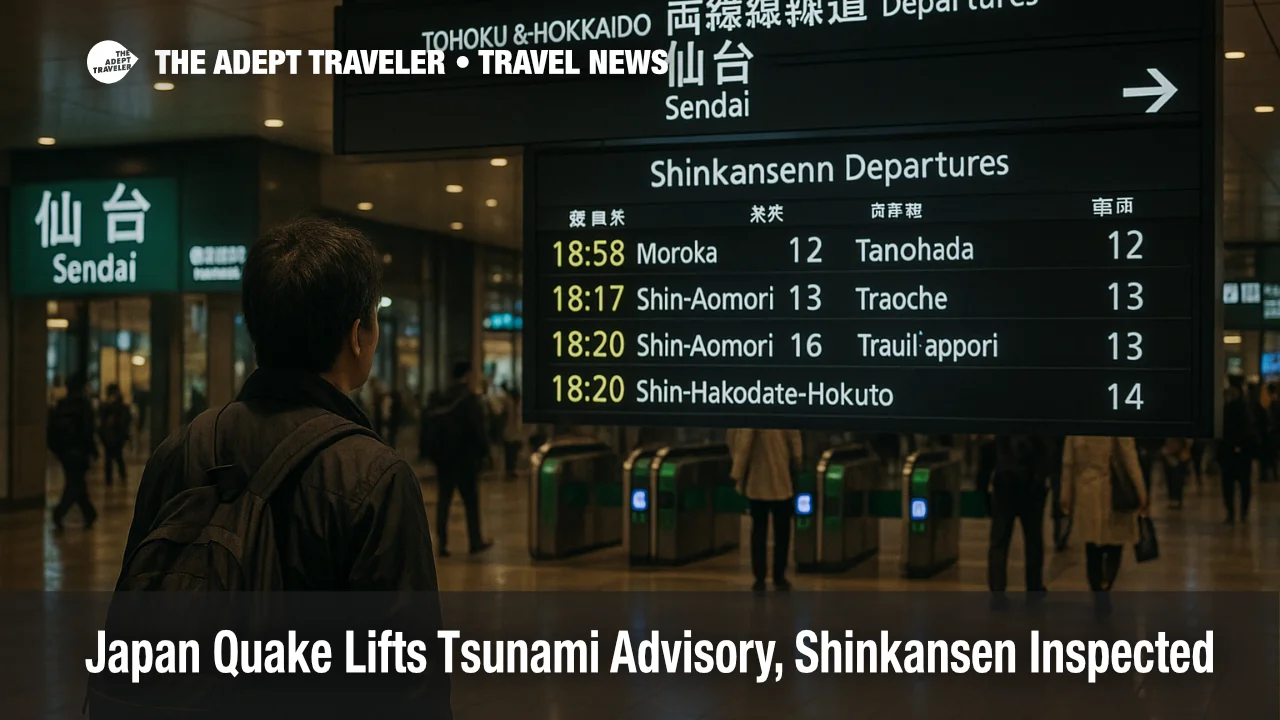Japan Quake Lifts Tsunami Advisory, Shinkansen Inspected

Key points
- A 6.9 quake struck off Iwate at 5:03 p.m. JST on November 9
- A tsunami advisory produced 10-20 cm waves and was lifted about three hours later
- JR East paused Tohoku Shinkansen service between Sendai and Shin Aomori during inspections
- Expect residual evening delays on Tohoku and Hokkaido connections and recheck Monday morning links
Impact
- Recheck Evening And Monday Links
- Confirm Tohoku Shinkansen departures, plus Limited Express and local feeders in Iwate, Miyagi, and Aomori
- Build Conservative Buffers
- Leave extra time for transfers at Sendai, Morioka, and Shin Aomori after rolling inspections
- Watch Airline Adjustments
- No widespread airport closures reported, but brief holds or spacing are possible at northern airports when checks occur
- Follow Local Guidance
- If near the coast, heed municipality advisories and avoid breakwaters when aftershocks are possible
- Ticket Changes
- Use JR East ticket offices or apps for delay certificates and seat changes if connections slip
A strong offshore earthquake struck near Iwate, Japan, on November 9 at 5:03 p.m. JST. The Japan Meteorological Agency issued a tsunami advisory for Iwate's Pacific coast that later recorded small waves, about 10 to 20 centimeters, then lifted the advisory roughly three hours after issuance. East Japan Railway, JR East, conducted safety inspections and temporarily suspended the Tohoku Shinkansen between Sendai and Shin Aomori, with bullet trains resuming after checks. Travelers connecting across Tohoku and into Hokkaido should recheck evening departures and build conservative buffers into early Monday transfers.
Tohoku Shinkansen and key rail pairs
JR East reported an instantaneous power loss on the Tohoku Shinkansen, which triggered an operations pause between Sendai and Shin Aomori while equipment and trackside systems were inspected. Once checks cleared, services restarted with delays and possible speed restrictions. Expect knock on effects on through services that bridge the Sendai, Morioka, Hachinohe, and Shin Aomori segments, plus timing slippage on Limited Express and local feeders used for last mile connections. JR East's public status pages outline how delay reporting works and emphasize that posted information may lag real time dispatch, so passengers should verify at the station board before boarding.
For itinerary planning, think in station pairs. The heaviest impacts this evening center on Sendai to Morioka, Morioka to Hachinohe, and Hachinohe to Shin Aomori, where inspections and recovery can cascade across rolling stock cycles. Through services to or from Tokyo can inherit upstream delays if trainsets arrive late at Sendai. If a tight cross platform transfer at Sendai or Morioka is part of your plan, pad the connection or accept a later departure to preserve reliability. JR East usually issues delay certificates that you can show to hotels or tour providers if arrival times slip.
Tsunami advisory timeline, what changed
The initial quake was reported at magnitude 6.7 to 6.9 off Iwate. A tsunami advisory warned of possible waves up to one meter, and small waves, 10 to 20 centimeters, were observed at Kuji, Miyako, Kamaishi, and Ofunato. The advisory was lifted shortly after 8:00 p.m. JST. Authorities noted an elevated chance of additional strong quakes over the next few days. Evacuation instructions in coastal districts were issued and later cleared. There were no abnormal readings reported at nearby nuclear facilities, and early tallies did not show significant damage.
Latest developments
JR East said bullet train operations were temporarily suspended between Sendai and Shin Aomori, then restarted after inspections. News desks in Tokyo reported temporary disruptions to select conventional lines and minor power issues in parts of the northeast. Evening services may still be delayed as equipment cycles and crew positions normalize. The Japan Meteorological Agency and civil authorities cautioned that aftershocks are possible in the coming days.
Analysis
For travelers, the most practical step is to convert this incident into buffers. If you are on a northbound Tohoku Shinkansen from Tokyo, expect platform changes and modest delays at Sendai, where inspections triggered the earlier pause. If your plan involves an evening transfer to Hokkaido via the Hokkaido Shinkansen, consider a conservative departure, since upstream timing depends on how quickly trainsets can be turned at Shin Aomori. If you are flying into northern Honshu tonight, the pattern after similar offshore quakes is brief checks of runways and facilities, not full closures. No widespread airport shutdowns were reported as of publication, but be ready for spacing or holds while inspections complete, especially at Sendai, Aomori, and Hakodate airports.
Background
How tsunami advisories work in Japan, the meteorological agency issues advisories when small to moderate waves are possible, often after offshore quakes. Ports and municipalities may direct people to avoid beaches, rivers, and harbors until the advisory clears. Railways conduct automatic and manual inspections after significant shaking is recorded, then restore service in phases, so short suspensions are common and are not a sign of structural damage by themselves.
Final thoughts
The primary facts for itinerary decisions are simple, the tsunami advisory ended on the evening of November 9, and JR East completed initial rail inspections with services resuming and delays possible. If your route crosses Sendai or Morioka, recheck departures tonight and again Monday morning, then carry an extra connection cushion.
Sources
- Powerful quake strikes off the coast of Japan, tsunami advisory lifted after 3 hours
- Tsunami threat passes following magnitude 6.9 quake off Iwate
- Japan issues tsunami advisory for Iwate prefecture in northern Japan, NHK says
- 6.9 earthquake strikes off the coast of Japan, tsunami threat passes
- Train Status Information, Tohoku Area, JR East
